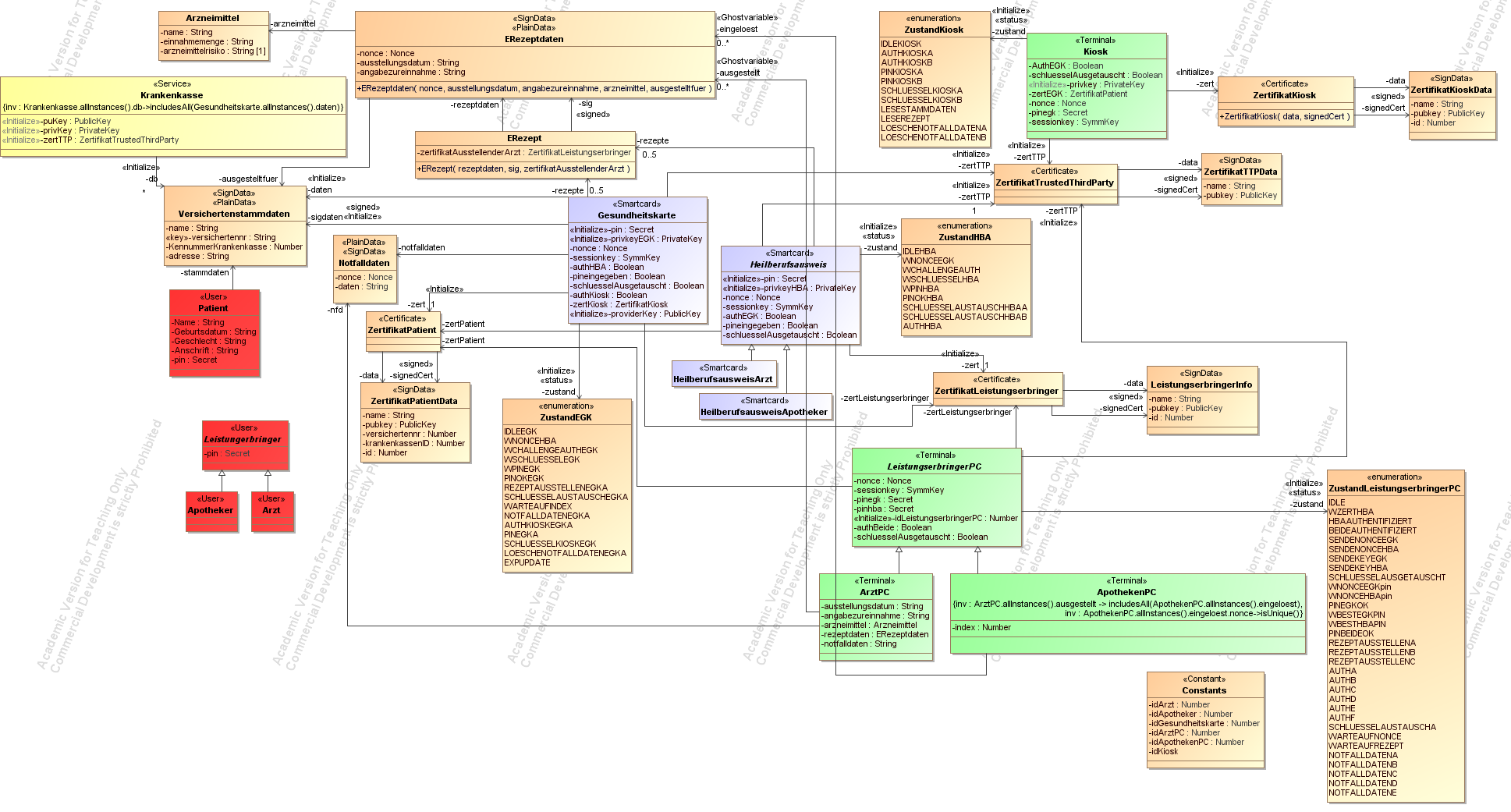[Impressum]
[E-Mail]
Modeling the German
Electronic Health Card (EGK) (2)
The
next step is to describe the components, data types and messages with UML class
diagrams.
- Classes with the stereotype <<Terminal>>, <<Smartcard>>, <<Service>> or <<User>>
describe components. This components have some attributes and
associations to other data classes and use
messages to interact with each other. We distinguish messages
that are exchanged between a terminal and a smartcard / service or
between two services (these are called messages) and messages that are
exchanged between a user and a terminal (these are called
usermessages). Messages are classes that are
derived from a class with the stereotype <<Message>>, usermessages from a
class with stereotype <<Usermessage>>.
In this example the messages as well as the usermessages are defined in
separate class diagrams (one for each protocol).
- The classes of the smartcard components (i.e. health card and
Heilberufsausweis) are marked blue. The abstract class
Heilberufsausweis is the superclass of the classes representing
the Heilberufsausweis of the doctor (HeilberufsausweisArzt)
und the one of the pharmacist (HeilberufsausweisApotheker). The classes of the terminal components are marked green. These
are the doctor's PC (ArztPC) and the pharmacy PC (ApothekenPC) which
have a common abstract superclass LeistungserbringerPC. Also, the kiosk
is modeled as a terminal. A kiosk is standing in a pharmacy and used by
a patient to read and update his personal data on the health card. The
user classes of the application are marked red. These are the patients,
the doctors (Arzt), the pharmacists (Apotheker). The classes Arzt and
Apotheker have an abstract common superclass called Leistungserbringer.
The health insurance company (Krankenkasse) is modeled as a service,
the class Krankenkasse is marked yellow. All other classes of the
diagram below are marked orange and describe the data of the
application. The enumerations define the possible states a component
may be in and the class Constants defines the constants used in thes
protocols.
- In the class diagram, the class ERezept represents an electronic
prescription.
An electronic prescription consists of three parts: the data of the
prescription, e.g. name and intake, as well as a
nonce which is
unique for each prescription, a digital signature of this data (issued
by the doctors Heilberufsausweis) as well as the certificate of the
doctor. The data of the prescription is stored in the class
ERezeptdaten. The class ERezept has two associations to the clas
ERezeptdaten. The association rezeptdaten stores the data itself, the
association sig (annotated with<< signed>>)
the signature of the data. The attribute zertifikatAusstellendeArzt of
class ERezept stores the certificate of the doctor (resp. his
Heilberufsausweis) who has issued the prescription.
- Three security properties are modeled for the application and were
verified interactively using the theorem prover KIV. The properties are
defined in the class diagram using OCL constraints:
- The first property states that all prescriptions that are
filled in a pharmacy were issued by a doctor previously. This implies
that only genuine prescriptions are filled. To be able to express the
property, two ghostvariables were added to the application model.If an attribute or association end in the class diagram is annotated with stereotype << Ghostvariable>>, this
denotes that this attribute or association end is used to express a security property
only. The
association between the Terminal class ArztPC (the doctors PC which is
used to issue the prescription) and the class ERezeptdaten (the data of
a prescription) with association end ausgestellt (issued) stores all
prescriptions that were issued by one doctor (using his PC). The
association between the Terminal class ApothekenPC (the PC in the
pharmacy which is used to fill prescriptions) and the class
ERezeptdaten with association end eingeloest (filled) stores all
prescriptions that were filled in one pharmacy (using the ApothekenPC).
The OCL formula inv : ArztPC.allInstances().ausgestellt -> includesAll(ApothekenPC.allInstances().eingeloest) is defined for the class ApothekenPC and expresses that all
prescriptions that are filled in a pharmacy were issued by a doctor
previously. For each terminal (doctor's PC and pharmacy PC) all
instances of that class, e.g. all PC's of all doctors and all pharmacy
PC's, are considered.
- Each prescription contains a nonce. If two prescriptions with
the same nonce exist, this means that an attacker was able fill a
prescreption twice. This is an attack of the system and has to be
forbidden by the application resp. the protocols. The second property
is used to express that all prescriptions that are filled in all
pharmacies have different nonces:
inv : ApothekenPC.allInstances().eingeloest.nonce->isUnique(). Since
we consider the prescriptions that were filled in all pharmacies, this
includes that one prescription is not filled in different pharmacies.
Note that the application model has no central component to store all
prescriptions that were issued and filled.
- The third security property states that all personal data (e.g.
name and insurance number) stored on a health card
(Versichertenstammdaten) of each patient cannot be manipulated by an
attacker. These data is updated by the health insurance company
(Krankenkasse) only. The update is done while the patient is visiting a
doctor, using the doctor's PC. The property, formulated as OCL formula,
is
inv : Krankenkasse.allInstances().db->includesAll(Gesundheitskarte.allInstances().daten). The
personal data stored on all health cards (association with end daten
between the class Gesundheitskarte and Versichertenstammdaten) is the
same as the one stored by the health insurance company (modelled by
association with end db between class Krankenkasse and class
Versichertenstammdaten). This means that the attacker is not able to
manipulate the personal data which was sent from the health insurance
company to the healthcard.
- The formal
model that is used for verification of the property is a distributed
system with finite but arbitrary components (e.g. smartcards,
terminals, services and user). The property has to hold for arbitrary
protocol runs that can be interleaved with other protocol runs.
Additionally, the attacker is able to interfere the communication as
defined in the deployment diagram.

Back, Next Step: Activity diagrams showing the interdependencies between the protocols
